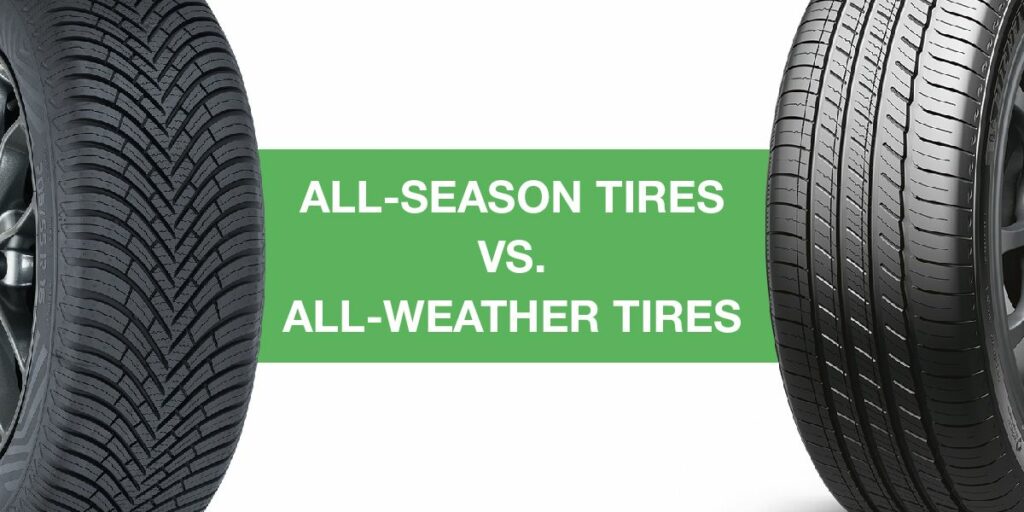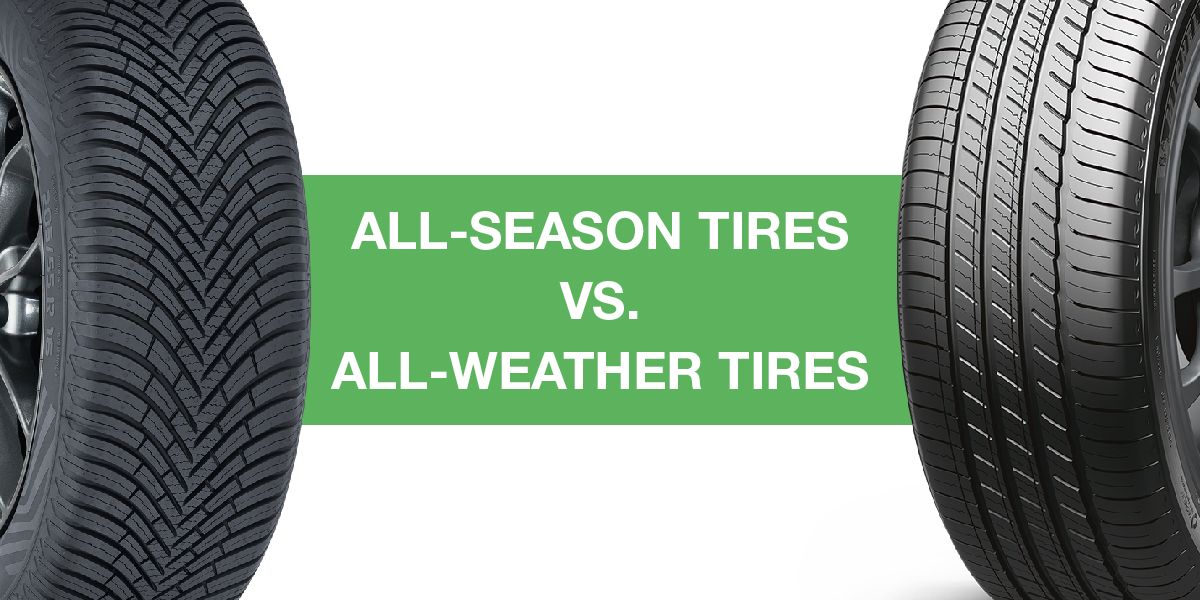
Are you searching for the differences between All-season and All-weather tires? While these tires can perform similar tasks and navigate harsh terrain, they aren't quite the same.
In this article, we will provide you with a detailed comparison between the All-Season and All-Weather tires based on various features. Thanks to this guide, you can make the right decision on what tire to choose for your use.
Without more talk, let’s hit the road.
All-Season vs. All-Weather Tires: An Overview of Differences
These two different types of tires have different features. Below is a table that shows an overview of differences between All-season and All-weather tires. Let's have a glance before moving on to the detailed comparison.
| All Season Tires | All-Weather Tires | |
| Tread Compound | Stiffens as temperature drops, but perfect for hot weather | Remains flexible above and below 7°C |
| Tread Pattern | Directional tread pattern | Asymmetric tire treads |
| Suitable Weather Conditions | Warm, dry and wet conditions(spring, summer, and fall) | Mild winter, heavy rain and, snowfall |
| Unsuitable Weather Conditions | Winter and snowfall | High-temperature deserts and extreme snow |
| Temperature | Above 7°C | Above and below 7°C |
| Lifespan | Longer | Shorter |
| Rating /Logo | (Mud + Snow) | (3-peak mountain/snowflake) |
All-Season vs. All-Weather Tires: Detailed Analysis
Tread Compound
To point out the difference between these two tire tread compounds, we must first establish what a tire's tread compound is. To put it simply, the tread compound of a tire is the tire rubber (what it's made of).
The tread compound for All-season tires is designed to provide a firm grip during warmer temperatures allowing it to perform optimally during summer, fall and spring. However, when the temperature drops, the tread will begin to stiffen.
While the tread compound of the All-season tire offers optimum performance during the summer, the All-weather tires feature a tread compound that makes it the best of both worlds. How? It thrives during the summer, spring and fall just like the All-season tire. Besides, the tread compound also offers you a strong performance during winter.
Tread pattern
All-season tires feature a directional tread pattern. This type of tread pattern is relatively straight and smooth. The reason for this feature is that they allow the tire to have a proper grip on the road in warm and hot temperatures, as well as repel water when it's raining. Tires with directional tread patterns roll in one direction. This pattern looks like an arrowhead as it features lateral grooves meeting at the middle of the tire's tread.
Also, the All-season tire's directional tread patterns help resist hydroplaning while giving it extra traction to navigate through muddy terrain and light snow. While the All-season tire mostly lives up to its name, you can't use it for all reasons as its name suggests. Meanwhile, the All-weather tire features an asymmetric tread pattern. For this type of tread pattern, The inner and outer halves have different tread blocks and channels.
The reason for such a design is to boost its performance in both wet and dry terrain. Furthermore, the asymmetric tread pattern of the All-weather tire increases overall handling, curve stability, and its ability to disperse water adequately.
Suitable Weather Conditions
The suitable weather conditions refer to the conditions in which the All-season and All-weather tires will perform excellently. The All-season tires will thrive the most in warm/hot, dry and wet weather conditions, or say, spring, summer and fall. Recently, several companies have started to refer to the All-season tires as "3-season tires". Its tread provides enough traction to have a solid grip in dry weather conditions. In contrast, its tread compound allows it to remain flexible even under extremely hot temperatures.
As we mentioned earlier, the All-weather tire is regarded as the best of two worlds. We recall this because All-weather tires are also suitable for dry and wet weather conditions. Also, with an All-weather tire, mild winters, heavy rainfall and shallow snow won't be an issue as it features a blocky tread that helps disperse slush, while providing proper stability and handling in warmer climates. Unlike the All-season tires, All-weather tires have much thicker rubber that allows for more traction and grip on cold surfaces.
Unsuitable Weather Conditions
If you are looking to drive in deep snow or extreme winter, unfortunately, neither the All-season nor All-weather tire can navigate such conditions. The All-season tire is worse off in snowy winter conditions than the All-weather tire as its grip and traction will be compromised at temperatures below 7 degrees Celsius. The "winter expert" honour goes to the winter tire, specifically designed for extreme winter. However, we won't be discussing winter tires in this article.
Furthermore, All-season tires will experience difficulties navigating through heavy rainfall. While the All-weather tire will perform well during the summer, it is not built to withstand hotter temperatures compared to the All-season tire.
Temperature
The temperature a tire is able to drive in and perform exceptionally heavily depends on its tread compound. For the All-season tire, its tread compound is designed to stay pliable at a minimum of 7°C or 44°F. However, All-season tires will perform optimally in warmer temperatures.
The All-weather tire has a softer tread compound (rubber) that stays pliable even at near-freezing temperatures, unlike the All-season tire. Consequently, navigating through the wet pavement, slush or snow during extremely cold weather conditions won't be too much of a hassle.
However, the All-weather tire's ability to outdo the All-season tire in cold temperatures comes with a price as it sacrifices grip and traction in warmer weather. As we see from the comparison table, the All-weather tire performs efficiently both below 7°C and above.
Lifespan
All-season tires last longer than All-weather tires as some of them have their treadwear warranty up to 90,000 miles, while All-weather tires come with a treadwear warranty up to 60,000 miles. Ultimately, you will have to replace the All-weather tires more often compared to the All-season tires.
The All-season tires last longer than their All-weather counterparts because they are built for the average driver. What makes them last longer is that they have a tread compound specially designed to offer a longer tread life. Also, the All-season tires have moderate tread depth.
Tire rating
Both the All-season and All-Weather tires have different tire ratings. The All-season tire has an M + S rating, while the All-weather tire has a 3-peak mountain/snowflake rating. But what does this mean? The "M" and "S" on the All-season tire stand respectively for mud and snow. This implies that the All-season tire is certified, having met the mandatory tire requirements in Canada.
Furthermore, the 3-peak mountain/snowflake badge assigned to the All-weather tire implies that it can be used safely in snowy conditions. Also, all All-weather tires are approved and recognized by transport Canada. You can see the logos associated with these tire ratings in the comparison table.
Conclusion
Both the All-season and All-Weather tires have their unique uses of which they live up to. Also, you should by no means try mixing both these tires as that would only cause complications. Thanks to this article, you now know the differences between the All-Season tires and the All-weather tires. With this information, knowing the right tire to use for every season and weather won't be a problem.
